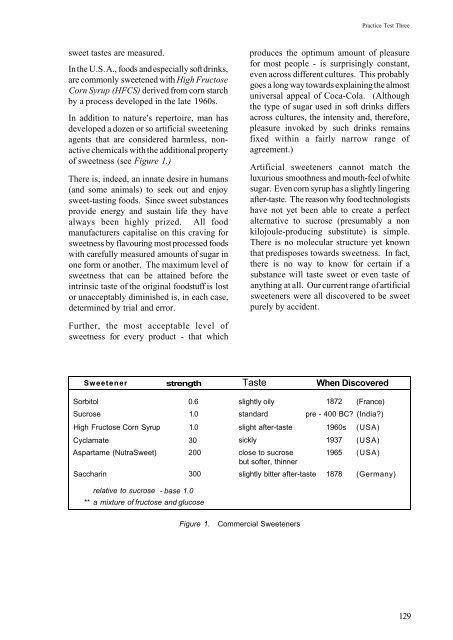You also want an ePaper? Increase the reach of your titles
YUMPU automatically turns print PDFs into web optimized ePapers that Google loves.
Practice Test Three<br />
sweet tastes are measured.<br />
In the U.S. A., foods and especially soft drinks,<br />
are commonly sweetened with High Fructose<br />
Corn Syrup (HFCS) derived from corn starch<br />
by a process developed in the late 1960s.<br />
In addition to nature's repertoire, man has<br />
developed a dozen or so artificial sweetening<br />
agents that are considered harmless, nonactive<br />
chemicals with the additional property<br />
of sweetness (see Figure 1.)<br />
There is, indeed, an innate desire in humans<br />
(and some animals) to seek out and enjoy<br />
sweet-tasting foods. Since sweet substances<br />
provide energy and sustain life they have<br />
always been highly prized. All food<br />
manufacturers capitalise on this craving <strong>for</strong><br />
sweetness by flavouring most processed foods<br />
with carefully measured amounts of sugar in<br />
one <strong>for</strong>m or another. The maximum level of<br />
sweetness that can be attained be<strong>for</strong>e the<br />
intrinsic taste of the original foodstuff is lost<br />
or unacceptably diminished is, in each case,<br />
determined by trial and error.<br />
produces the optimum amount of pleasure<br />
<strong>for</strong> most people - is surprisingly constant,<br />
even across different cultures. This probably<br />
goes a long way towards explaining the almost<br />
universal appeal of Coca-Cola. (Although<br />
the type of sugar used in soft drinks differs<br />
across cultures, the intensity and, there<strong>for</strong>e,<br />
pleasure invoked by such drinks remains<br />
fixed within a fairly narrow range of<br />
agreement.)<br />
Artificial sweeteners cannot match the<br />
luxurious smoothness and mouth-feel of white<br />
sugar. Even corn syrup has a slightly lingering<br />
after-taste. The reason why food technologists<br />
have not yet been able to create a perfect<br />
alternative to sucrose (presumably a non<br />
kilojoule-producing substitute) is simple.<br />
There is no molecular structure yet known<br />
that predisposes towards sweetness. In fact,<br />
there is no way to know <strong>for</strong> certain if a<br />
substance will taste sweet or even taste of<br />
anything at all. Our current range of artificial<br />
sweeteners were all discovered to be sweet<br />
purely by accident.<br />
Further, the most acceptable level of<br />
sweetness <strong>for</strong> every product - that which<br />
Sweetener<br />
strength<br />
Taste<br />
When Discovered<br />
Sorbitol<br />
Sucrose<br />
High Fructose Corn Syrup<br />
Cyclamate<br />
Aspartame (NutraSweet)<br />
Saccharin<br />
0.6<br />
1.0<br />
1.0<br />
30<br />
200<br />
300<br />
slightly oily<br />
standard<br />
slight after-taste<br />
sickly<br />
close to sucrose<br />
but softer, thinner<br />
1872 (France)<br />
pre - 400 BC? (India?)<br />
1960s<br />
1937<br />
1965<br />
slightly bitter after-taste 1878<br />
(USA)<br />
(USA)<br />
(USA)<br />
(Germany)<br />
relative to sucrose<br />
- base 1.0<br />
** a mixture of fructose and glucose<br />
Figure 1.<br />
Commercial Sweeteners<br />
129




